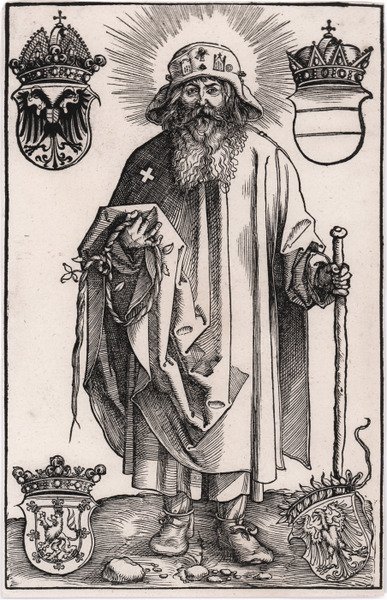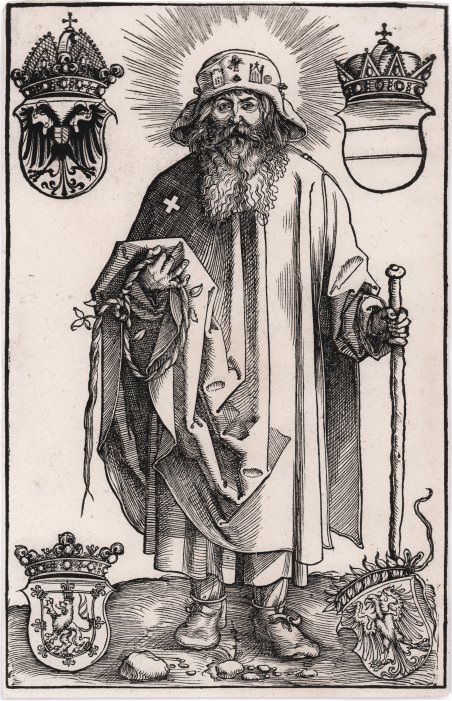Xilografia, 1513, senza monogramma. In una lettera indirizzata a Dürer da Nikolaus Kratzer (1486-155), astronomo di corte del re Enrico VIII d'Inghilterra, Kratzer chiede a Dürer: "Ti prego di mandarmi il ritratto di Stabius, raffigurato come San Kolman, tagliato in legno". La paternità dureriana di questa xilografia non è stata ancora accettata da tutti. Strauss la include tra le xilografie per la forte possibilità che sia basata su un disegno di Dürer, forse frettoloso, e poi tagliata nel blocco senza la sua super visione. Dodgson attribuisce questa stampa a Springinklee, come fa Meder, mentre Schoch afferma che la figura è disegnata troppo bene per essere stata disegnata da Springinklee. L'assenza del suo monogramma non può essere necessariamente interpretata come un'indicazione che Dürer non sia l'autore, perché la xilografia serviva come illustrazione di un foglio accompagnato da un'ode saffica di Stabius, e recante, sopra l’immagine, il seguente testo 'Divo Colomanno martyri sancto: Austrieque patrono/ presentissimo: Joann. Stabius. Au. voti reus. Hoc/ carmen dedicat. Anno dni. etc. M.D.xiij' Dürer conosceva bene Johannes Stabius (morto nel 1522), filosofo e astronomo di corte dell'imperatore Massimiliano. Stabius accompagnò l'imperatore nella sua visita a Norimberga, 3-15 febbraio 1512, ma a quanto pare rimase più a lungo perché il 30 luglio ha preparato un oroscopo a Norimberga per Matthäus von Gurk . Stabius è qui raffigurato nelle vesti di San Colomanno, venerato in Austria. Il santo fu impiccato nel 1020 a Stockerau. Indossa un cappello da pellegrino e tiene nella mano sinistra una frusta intrecciata. I quattro stemmi sono (in senso orario) quelli dell'Impero, dell'Arciducato d'Austria, della Scozia e di Stabius. San Colomanno, secondo la leggenda, era un discendente della famiglia reale scozzese. Magnifica impressione, impressa su carta vergata con filigrane doppia croce e lettere ICP”, in perfetto stato di conservazione. Esemplare nella seconda edizione descritta da Meder e pubblicata da Adam von Bartsch utilizzando la matrice originale conservata all’Albertina di Vienna e datata 1781. Woodcut, 1513, without monogram. In a letter, addressed to Dürer by Nikolaus Kratzer (1486-155), court astronomer to King Henry VIII of England, Kratzer asks Dürer: “I beg you to send me the portrait of Stabius, portrayed as Saint Kolman, cut into wood. "Yet Dürer's authorship of this woodcut has not gained general acceptance Dodgson attributes this print to Springinklee, as does Meder, while Schoch states that the figure is drawn too well to have been designed by Springinklee. Strauss included it among on Dürer’s woodcuts because of the very strong possibility that it is based on a drawing by Dürer, perhaps a hasty one, due to his preoccupation with the master engravings of this period, and then cut into the block without his super vision. The absence of his monogram cannot necessarily be construed as an indication that Dürer was not the author because the woodcut served as illustration of a broadsheet accom panied by a sapphic ode by Stabius, lettered above the woodcut on left sheet: 'Divo Colomanno martyri sancto: Austrieque patrono presentissimo: Joann. Stabius. Au. voti reus. Hoc carmen dedicat. Anno dni. etc. M.D.xiij' ' Dürer was well acquainted with Johannes Stabius (d. 1522), philosopher, and court astronomer to Emperor Maximilian (see the following woodcuts). Stabius accompanied the emperor on his visit to Nuremberg, 3-15 February 1512, but apparently stayed on for some time because on 30 July he prepared a horoscope at Nuremberg for Matthäus von Gurk. Stabius is pictured here in the guise of St. Coloman, venerated in Austria. The saint was hanged in A.D. 1020 at Stockerau. Wearing a pilgrim's hat, he is holding in his left hand a braided whip. The four coats of arms are (clockwise) those of the Empire, the Archduchy of Austria, Scotland, and of Stabius. St. Coloman, according to legend, was a descendant of the Scottish royal family” (cf. Strauss. p. 483). Example of the second issue described by Meder, printed by Bartsch from the block in the Albertina dated MDCCLXXXI. A fine impression, printed on laid paper with “ICP with Doublecross” watermark, perfect condition. Cfr. Bartsch, 106; Meder n. 194; TIB 1001.306 (137): Strauss, p. 483-485, n. 169.


Scopri come utilizzare
Scopri come utilizzare

